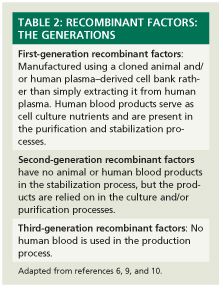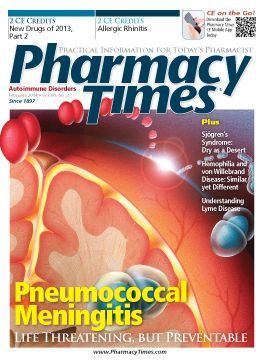Hemophilia and von Willebrand Disease: Similar, yet Different
Pharmacists can encourage patients to obtain prophylaxis and carry medic alert information.
Pharmacists can encourage patients to obtain prophylaxis and carry medic alert information.
Bleeding disorders—particularly hemophilia and von Willebrand disease (vWD) (Online Table 1)—create large demands on health care resources. Certain problems signal hemophilia as a possible diagnosis: bruising easily in early childhood, spontaneous bleeding (particularly into the joints, muscles, and soft tissues), or profuse life-threatening bleeding after trauma or surgery. Hemophilia usually results in lifelong bleeding problems that correlate with the patient’s clotting factor level, although some infants are asymptomatic until they become active toddlers and experience minor trauma. Patients frequently report “auras” that precede other physical signs.1,2
vWD results from qualitative or quantitative deficiency of von Willebrand factor (vWF), a multimeric protein crucial for platelet adhesion.3,4 Symptoms are primarily easy bruising, nosebleeds, bleeding gums, and bleeding after dental extraction. It is diagnosed more often in women than in men, mainly because menstruation can be quite heavy in affected women.5 (Affected women also often hemorrhage heavily during childbirth.)
Definitive diagnosis depends on laboratory assay to demonstrate the patient’s specific deficiency. Through treatment, health care providers aim to prevent bleeding using either DDAVP (desmopressin) or the deficient factor.6
Table 1: Hemophilia and von Willebrand Disease
Bleeding Disorder
Key Points
Hemophilia
- Rare (1/10,000 births); difficult to diagnose X-linked congenital bleeding disorder
- Usually transmitted through maternal lines to male offspring
- Up to one-third of all cases caused by spontaneous mutation, not family history
- Clotting factor mutations cause coagulation factor deficiencies Hemophilia A: Coagulation factor VIII deficiency; represents 80% to 85% of hemophiliacs, affecting 21/100,000 males, with ~50% classified as severe Hemophilia B: Coagulation factor IX deficiency, affecting 1/100,000 males, with 44% classified as severe
von Willebrand disease
- The most common hereditary coagulation abnormality; affects approximately 1% of the population, but only 0.01% is symptomatic
- Symptomatic patients can be severely ill and need regular replacement therapy
- Does not usually cause bleeding into joints or internal bleeding
- Type O blood may increase risk and severity
Adapted from references 1-4.
Treatment Options
People with hemophilia need comprehensive care encompassing vein care and preservation; exercise programs and other measures to stimulate normal psychomotor development; regular health status monitoring; and good oral hygiene. In addition, patients, health care providers, and caregivers must remember to avoid drugs that affect platelet function (eg, aspirin, nonsteroidal anti-inflammatory drugs).6
Although similar, hemophilia and vWD have important differences. Bleeding location and severity vary more for vWD patients than for hemophilia patients.
- vWF targets skin and mucous membranes (the lining of the nose, mouth, intestines, uterus, and vagina), so a deficiency causes more bleeding at these sites.
- Factors VIII and IX (FVIII and FIX) are more important in deep tissues, so hemophilia causes more bleeding in joints and within muscles.
vWF and FVIII behave differently kinetically. When patients with severe vWD and a very low level of FVIII receive vWF—FVIII concentrates, their FVIII level rises immediately. Endogenous FVIII binds the infused vWF. FVIII then declines and then rises as stabilization occurs. Available factor products have different FVIII and vWF content, an important point when treating vWD patients. Some products cannot be used for treating vWD, and this is noted on product labels.2
Desmopressin
Desmopressin (DDAVP), a synthetic vasopressin analogue, releases FVIII and vWF stores from endothelial cells, boosting plasma levels. In patients with mild to moderate hemophilia A, administering DDAVP can raise the FVIII level 3 to 6 times the baseline level and can control bleeding. In vWD, responses to desmopressin vary.7 DDAVP is the treatment of choice in hemophilia carriers and patients who have vWD with FVIII and vWF levels >10 U/dL who have responded to a test infusion.5 DDAVP costs less than—and avoids viral transmission hazards associated with—clotting factor concentrates (see below). DDAVP has no effect on FIX levels and is ineffective for hemophilia B.6
Patients’ response to DDAVP varies, so pretreatment testing is necessary. Desmopressin can be administered subcutaneously (most common), by intravenous (IV) infusion, or nasally. In vWD, high-dose nasal administration often resolves minor bleeding, but surgical bleeding prophylaxis and major hemorrhage call for IV administration.5,6,8 Tachyphylaxis (decreased response) can develop with repeated or closely spaced doses, so dosing is limited to 3 consecutive days. If patients need higher factor levels, supplemental factor concentrates are indicated.5,6
DDAVP-associated water retention and hyponatremia rarely occur in patients. Patients must limit fluid intake to less than 1 L per day. DDAVP is contraindicated in children younger than 2 years due to risk of cerebral edema and seizures. Reports of thrombosis (including myocardial infarction) after desmopressin infusion should prompt vigilance in patients with history or risk of cardiovascular disease.5,6,8
Clotting Factors
Until the 1990s, people with hemophilia were at high risk for chronic, life-threatening blood-borne viral diseases from contaminated blood products. Exclusion of at-risk donors, improved screening of donated blood, and use of in-process viral inactivation and/or a removal step have improved safety. Additionally, manufacturers can use recombinant DNA technology to produce FVIII and FIX.6,9 A small risk of acquiring prion-mediated disease from plasma-derived products still exists.9

Experts who treat hemophiliacs—and these patients need expert care—generally follow National Hemophilia Association Medical and Scientific Advisory Council or World Federation of Hemophilia 2013 guidelines.6,9 Hemophilia patients with a clotting factor level >1 IU/dL seldom bleed spontaneously; guidelines provide specific bleeding prophylaxis dosing instructions to prevent bleeding and joint destruction. They tailor care to the individual. Usually, patients receive prophylactic FVIII or FIX 2 to 3 times weekly to keep trough FVIII or FIX levels at 2% to 3%.
Product purity and viral inactivation/elimination are critical issues.5,6 Manufacturers produce recombinant products using genetically engineered cloned cells (Table 2; Online Sidebar).
Patients can develop inhibitors—IgG antibodies that neutralize clotting factors— to platelet-derived or recombinant FVIII or FIX. When previously responsive patients fail to respond to treatment or respond less robustly than expected, clinicians should suspect inhibitor development. Currently, inhibitors are the most challenging treatment-related complication. The likelihood of inhibitor development is greatest in severe hemophilia.
Acute Bleeds
During acute bleeds, experts say, “If in doubt, treat,” preferably within 2 hours. The bleeding site is usually obvious. For severe or life-threatening bleeding, patients need appropriate clotting factor by IV push over 1 to 2 minutes followed by 4 to 8 weeks of prophylaxis. In emergencies, patients often bring their own clotting factor or desmopressin with them. They should be allowed to use it.6,11
Final Note
Prophylaxis eliminates expensive management of damaged joints and improves quality of life, making it cost-effective over time.12 Long-term prophylaxis is not used as often in vWD as in hemophilia, but studies are under way to evaluate prophylaxis in vWD patients and determine optimal dosing.2
Pharmacists should encourage all patients with bleeding disorders to carry medic alert information. It should indicate the diagnosis; the bleeding disorder’s severity; inhibitor status; type of treatment product used; initial dose for treatment of severe, moderate, or mild bleeding; and the treating physician’s (or clinic’s) contact information.6
Sidebar: New Indication for Anti-Inhibitor Coagulant Complex
On December 23, 2013, the FDA approved a new indication for Baxter’s anti-inhibitor coagulant complex (Feiba). Previously indicated for control of spontaneous bleeding episodes and to cover surgical interventions in hemophilia A and hemophilia B patients who have inhibitors, Feiba can now be used for routine prophylaxis to prevent bleeding in patients with hemophilia A or B who have developed inhibitors.
Approved based on a pivotal phase 3 trial that enrolled 36 hemophilia A or B patients who had developed inhibitors, anti-inhibitor coagulant complex prophylaxis produced a 72% reduction in annual bleed rate compared with on-demand treatment. The most common adverse reactions were anemia, diarrhea, hemarthrosis, hepatitis B surface antibody positivity, nausea, and vomiting. Serious adverse reactions seen with Feiba in all trials included hypersensitivity reactions and thromboembolic events (stroke, pulmonary embolism, and deep vein thrombosis).
Ms. Wick is a visiting professor at the University of Connecticut School of Pharmacy with interests in medical history and how society views and addresses issues related to prescription drugs.
References
- Rosendaal FR, Briet E. The increasing prevalence of haemophilia. Thromb Haemostasis. 1990;63:145.
- Castaman G, Eikenboom JCJ, Bertina RM, Rodeghiero F. Inconsistency of association between type 1 von Willebrand disease phenotype and genotype in families identified in an epidemiological investigation. Thromb Haemost. 1999;82:1065-1070.
- De Meyer SF, Deckmyn H, Vanhoorelbeke K. von Willebrand factor to the rescue. Blood. 2009;113:5049-5057.
- Castaman G, Goodeve A, Eikenboom J; European Group on von Willebrand Disease. Principles of care for the diagnosis and treatment of von Willebrand disease. Haematologica. 2013;98:667-674.
- Srivastava A, Brewer AK, Mauser-Bunschoten, et al; Treatment Guidelines Working Group on Behalf of The World Federation of Hemophilia. Guidelines for the management of hemophilia. Haemophilia. 2013;19:e1-e47.
- Rodeghiero F, Castaman G, Di Bona E, Ruggeri M. Consistency of responses to repeated DDAVP infusions in patients with von Willebrand’s disease and hemophilia A. Blood. 1989;74:1997-2000.
- Stimate [prescribing information]. CSL Behring; November 2012.
- MASAC recommendations concerning products licensed for the treatment of hemophilia and other bleeding disorders; document 215. National Hemophilia Foundation website. www.hemophilia.org/NHFWeb/MainPgs/MainNHF.aspx?menuid=57&contentid=693. Accessed June 10, 2013.
- Masset GV. New treatment modalities; recombinant factor VIII Products: factor VIII after 2008. www.vcuhealth.org/cvccd/pdf/Factor%20VIII%20Update.ppt. Accessed June 10, 2013.
- Guidelines for emergency department management of individuals with hemophilia. National Hemophilia Foundation website. www.hemophilia.org/NHFWeb/MainPgs/MainNHF.aspx?menuid=57&contentid=691. Accessed June 10, 2013.
- Ljung R. Hemophilia and prophylaxis. Pediatr Blood Cancer. 2013;60(suppl 1):S23-S26.

